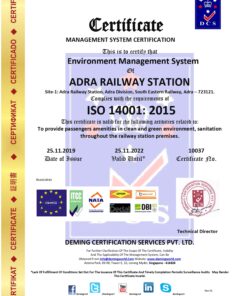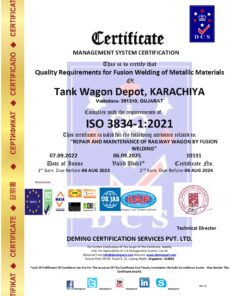Sale!
ISO 14001: Environmental Management System
Original price was: ₹30,000.00.₹15,000.00Current price is: ₹15,000.00.
ISO 14001 is an international standard that specifies requirements for an effective Environmental Management System (EMS). An EMS helps organizations identify, manage, monitor, and control their environmental aspects and impacts, as well as improve their environmental performance.
Here are the key components and principles of ISO 14001:
### Key Components:
1. **Environmental Policy**: An organization must establish an environmental policy that outlines its commitment to environmental protection and compliance with applicable legal requirements.
2. **Planning**: This involves identifying environmental aspects associated with an organization’s activities, products, and services, and determining significant environmental impacts. Objectives, targets, and programs are then developed to address these impacts.
3. **Implementation and Operation**: This involves implementing the necessary processes, procedures, and controls to achieve the organization’s environmental objectives and targets. It includes training employees, communicating environmental responsibilities, and ensuring the availability of resources.
4. **Checking and Corrective Action**: Organizations must monitor and measure their environmental performance against their objectives and targets. They must also establish procedures for identifying and correcting any non-conformities and taking corrective actions.
5. **Management Review**: Senior management must review the organization’s EMS at planned intervals to ensure its continued suitability, adequacy, and effectiveness.
### Principles:
1. **Commitment to Environmental Protection**: Top management should demonstrate leadership and commitment to environmental protection.
2. **Compliance with Legal and Other Requirements**: Organizations must comply with applicable legal requirements and other requirements to which they subscribe related to their environmental aspects.
3. **Continual Improvement**: Organizations should continually strive to improve their environmental performance by setting and achieving environmental objectives and targets.
4. **Pollution Prevention**: The standard emphasizes the importance of preventing pollution at the source rather than treating it after it has been created.
5. **Stakeholder Engagement**: Organizations should engage with internal and external stakeholders, including employees, customers, and the community, to understand their environmental concerns and expectations.
6. **Risk-Based Thinking**: Organizations should consider the environmental risks and opportunities associated with their activities, products, and services and take actions to mitigate risks and capitalize on opportunities.
### Benefits of Implementing ISO 14001:
1. **Improved Environmental Performance**: Organizations can reduce their environmental impacts and achieve operational efficiencies.
2. **Compliance with Legal Requirements**: Organizations can ensure compliance with environmental laws and regulations.
3. **Cost Savings**: By reducing waste and improving resource efficiency, organizations can achieve cost savings.
4. **Enhanced Reputation**: Implementing ISO 14001 can enhance an organization’s reputation and demonstrate its commitment to environmental responsibility to stakeholders.
5. **Competitive Advantage**: Organizations with ISO 14001 certification may gain a competitive advantage in the marketplace by demonstrating their commitment to environmental management.
Implementing ISO 14001 requires commitment and involvement from all levels of an organization. It is a systematic approach to managing environmental responsibilities and can bring tangible benefits to organizations that adopt it.












Reviews
There are no reviews yet.